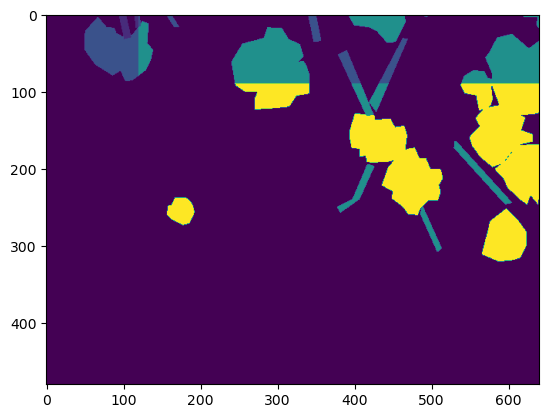f = gpd.read_file('example_data/R70C21.shp')
f.head()
f['label_id'] = f.apply(lambda row: 2 if row.label == 'Standing' else 1, axis=1)
f.to_file('example_data/R70C21.shp')Tiling
Tiler
Tiler (outpath, gridsize_x:int=400, gridsize_y:int=400, overlap:Tuple[int,int]=(100, 100))
Similar functions than ´solaris.tile.raster_tile’ but with more recent dependencies.
Tiler.tile_raster
Tiler.tile_raster (path_to_raster:str, allow_partial_data:bool=False)
Tiles specified raster to self.gridsize_x times self.gridsize_y grid, with self.overlap pixel overlap
Tiler.tile_vector
Tiler.tile_vector (path_to_vector:str, min_area_pct:float=0.0)
Tiles a vector data file into smaller tiles. Converts all multipolygons to a regular polygons. min_area_pct is be used to specify the minimum area for partial masks to keep. Default value 0.0 keeps all masks.
Tiler.tile_and_rasterize_vector
Tiler.tile_and_rasterize_vector (path_to_raster:str, path_to_vector:str, column:str, keep_bg_only:bool=False)
Rasterizes vectors based on tiled rasters. Requires that shapefile has numeric data in column. By default only keeps the patches that contain polygon data, by specifying keep_bg_only=True saves also masks for empty patches.
untile_vector
untile_vector (path_to_targets:str, outpath:str, non_max_suppression_thresh:float=0.0, nms_criterion:str='score')
Create single shapefile from a directory of predicted shapefiles
copy_sum
copy_sum (merged_data, new_data, merged_mask, new_mask, **kwargs)
Make new pixels have the sum of two overlapping pixels as their value. Useful with prediction data
untile_raster
untile_raster (path_to_targets:str, outfile:str, method:str='first')
Merge multiple patches from path_to_targets into a single raster`
Example area looks like this
from rasterio import plot as rioplotraster = rio.open('example_data/R70C21.tif')
rioplot.show(raster)
<Axes: >With rasterio.plot it is a lot easier to visualize shapefile and raster simultaneously
fig, ax = plt.subplots(1,1)
rioplot.show(raster, ax=ax)
f.plot(ax=ax, column='label_id')<Axes: >
Let’s tile image into 240x180 sized patches using overlap of half patch size.
tiler = Tiler(outpath='example_data/tiles', gridsize_x=240, gridsize_y=180, overlap=(120, 90))tiler.tile_raster('example_data/R70C21.tif')tiler.tile_vector('example_data/R70C21.shp', min_area_pct=.2)Untile shapefiles and check how they look
untile_vector(f'example_data/tiles/vectors', outpath='example_data/untiled.geojson')81 polygons before non-max suppression
81 polygons after non-max suppressionPlot with the tiled grid.
untiled = gpd.read_file('example_data/untiled.geojson')
fig, ax = plt.subplots(1,1)
rioplot.show(raster, ax=ax)
tiler.grid.exterior.plot(ax=ax)
untiled.plot(ax=ax, column='label_id', facecolor='none', edgecolor='black')<Axes: >
If allow_partial_data=False as is the default behaviour, tiling is done only for the area from which full sized patch can be extracted. With allow_partial_data=True, windows can “extend” to empty areas. This is useful with inference, when predicted areas can have wonky dimensions.
tiler.tile_raster('example_data/R70C21.tif', allow_partial_data=True)tiler.tile_vector('example_data/R70C21.shp', min_area_pct=.2)Untile shapefiles and check how they look
untile_vector(f'example_data/tiles/vectors', outpath='example_data/untiled.geojson')81 polygons before non-max suppression
81 polygons after non-max suppressionuntiled = gpd.read_file('example_data/untiled.geojson')
fig, ax = plt.subplots(1,1)
rioplot.show(raster, ax=ax)
#tiler.grid.exterior.plot(ax=ax)
untiled.plot(ax=ax, column='label_id', facecolor='none', edgecolor='black')<Axes: >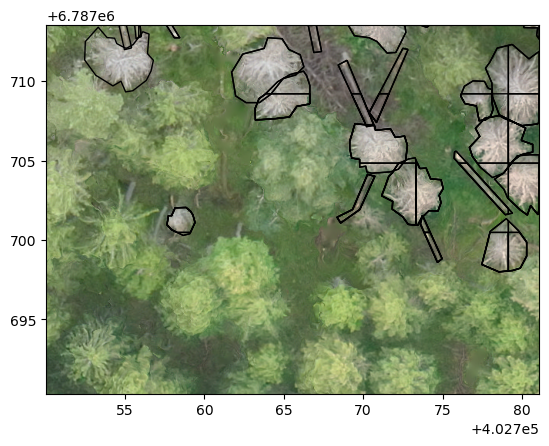
Plot with the tiled grid.
untiled = gpd.read_file('example_data/untiled.geojson')
fig, ax = plt.subplots(1,1)
rioplot.show(raster, ax=ax)
tiler.grid.exterior.plot(ax=ax)
untiled.plot(ax=ax, column='label_id')<Axes: >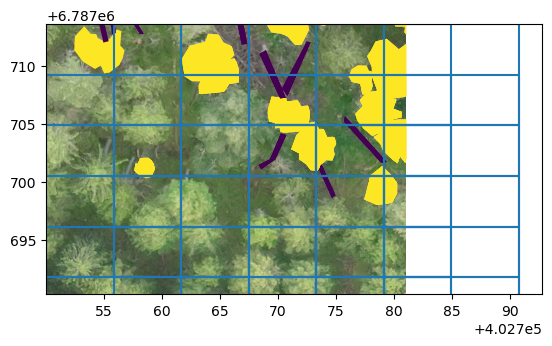
tiler.tile_and_rasterize_vector('example_data/R70C21.tif', 'example_data/R70C21.shp', column='label_id')tiler.tile_and_rasterize_vector('example_data/R70C21.tif', 'example_data/R70C21.shp',
column='label_id', keep_bg_only=True)import matplotlib.pyplot as pltwith rio.open('example_data/tiles/rasterized_vectors/R1C3.tif') as i: im = i.read()
plt.imshow(im[0])<matplotlib.image.AxesImage>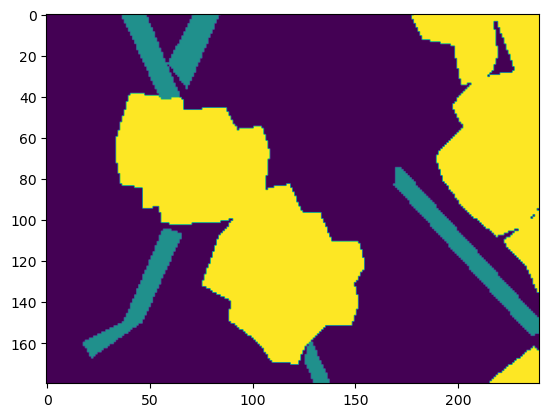
untile_raster can be used to mosaic all patches into one.
untile_raster('example_data/tiles/rasterized_vectors/', 'example_data/tiles/mosaic_first.tif',
method='first')with rio.open('example_data/tiles/mosaic_first.tif') as mos: mosaic = mos.read()
plt.imshow(mosaic[0])<matplotlib.image.AxesImage>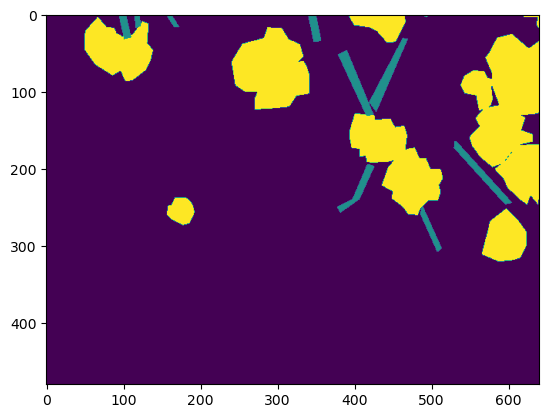
By specifying method as sum it’s possible to collate predictions and get the most likely label for pixels
untile_raster('example_data/tiles/rasterized_vectors/', 'example_data/tiles/mosaic_sum.tif',
method='sum')with rio.open('example_data/tiles/mosaic_sum.tif') as mos: mosaic = mos.read()
plt.imshow(mosaic[0])<matplotlib.image.AxesImage>